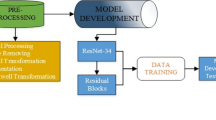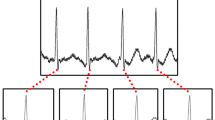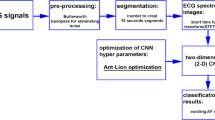Abstract
Atrial fibrillation (AF) is one of the most common arrhythmia diseases, the incidence of which is ascendant with age increase. What’s more, AF is a high-risk factor for stroke, ischemia myocardial and other malignant cardiovascular diseases, which would threaten people’s life significantly. Using a mobile device to screen AF segments is an effective way to reduce the mortality and morbidity of malignant cardiovascular diseases. However, most of existing AF detection methods mainly centered on clinical resting ECG signals and were incapable of processing mobile ECG signals with low signal-to-noise ratio which collected by mobile devices. In this paper, we take advantage of a fully convolutional network variant named U-Net for heart rhythmic information capturing by locating R peak positions as well as calculating RR intervals and a 34-layer residual network for waveform morphological features capturing from ECG signals. Combining both rhythmic information and waveform morphological features, two-layer fully connected networks are employed successively to discriminate AF, normal sinus rhythm , and other abnormal rhythm (other). The extensive experimental results show that our proposed AF our proposed AF screening framework named FRM-CNN can achieve \(F_{1}\) value of 85.08 ± 0.99% and accuracy of \(87.22 \pm 0.71\)% on identifying AF segments well without handcraft engineering. Compared with the cutting-edge AF detection methods, the FRM-CNN has more superior performance on monitoring people’s health conditions with mobile devices.








Similar content being viewed by others
References
Camm AJ, Kirchhof P, Lip GYH et al (2010) Guidelines for the management of atrial fibrillation. Eur Heart J 31(19):2369–2429
Rahman F, Kwan GF, Benjamin EJ (2014) Global epidemiology of atrial fibrillation. Nat Rev Cardiol 11(11):639
Heeringa J, van der Kuip DAM, Hofman A et al (2006) Prevalence, incidence and lifetime risk of atrial fibrillation: the Rotterdam study. Eur Heart J 27(8):949–953
Hassan AR et al (2016) Computer-aided obstructive sleep apnea screening from single-lead electrocardiogram using statistical and spectral features and bootstrap aggregating. Biocybern Biomed Eng 36(1):256–266
Hassan AR et al (2017) An expert system for automated identification of obstructive sleep apnea from single-lead ECG using random under sampling boosting. Neurocomputing 235:122–130
Hassan AR et al (2016) Computer-aided obstructive sleep apnea identification using statistical features in the EMD domain and extreme learning machine. Biomed Phys Eng Exp 2(3):035003
Hassan AR (2015) Automatic screening of obstructive sleep apnea from single-lead electrocardiogram. In: 2015 international conference on electrical engineering and information communication technology (ICEEICT). IEEE
Hassan AR (2015) A comparative study of various classifiers for automated sleep apnea screening based on single-lead electrocardiogram. In: 2015 International conference on electrical and electronic engineering (ICEEE). IEEE
Guidera SA, Steinberg JS (1993) The signal-averaged P wave duration: a rapid and noninvasive marker of risk of atrial fibrillation. J Am Coll Cardiol 21(7):1645–1651
Mehta S, Lingayat N, Sanghvi S (2009) Detection and delineation of P and T waves in 12-lead electrocardiograms. Exp Syst 26(1):125–143
Dilaveris PE, Gialafos JE (2001) P-wave dispersion: a novel predictor of paroxysmal atrial fibrillation. Ann Noninvasive Electrocardiol 6(2):159–165
Aytemir K et al (2000) P wave dispersion on 12-lead electrocardiography in patients with paroxysmal atrial fibrillation. Pacing Clin Electrophysiol 23(7):1109–1112
Zhou X et al (2014) Automatic online detection of atrial fibrillation based on symbolic dynamics and Shannon entropy. Biomed Eng Online 13(1):18
Huang C et al (2011) A novel method for detection of the transition between atrial fibrillation and sinus rhythm. IEEE Trans Biomed Eng 58(4):1113–1119
Tateno K, Glass L (2000) A method for detection of atrial fibrillation using RR intervals. Comput Cardiol 27:391–394
Lian J, Wang L, Muessig D (2011) A simple method to detect atrial fibrillation using RR intervals. Am J Cardiol 107(10):1494–1497
Dash S et al (2009) Automatic real time detection of atrial fibrillation. Ann Biomed Eng 37(9):1701–1709
Billeci L et al (2017) Detection of AF and other rhythms Using RR variability and ECG spectral measures. Computing 44:1
Dai H, Jiang S, Li Y (2013) Atrial activity extraction from single lead ECG recordings: evaluation of two novel methods. Comput Biol Med 43(3):176–183
Fan X et al (2018) Multiscaled fusion of deep convolutional neural networks for screening atrial fibrillation from single lead short ECG recordings. IEEE J Biomed Health Inform 22(6):1744–1753
Pourbabaee B, Mehrsan Javan R, Khashayar K (2017) Deep convolutional neural networks and learning ecg features for screening paroxysmal atrial fibrillation patients. IEEE Trans Syst Man Cybern Syst 99:1–10
Daqrouq K et al (2014) Neural network and wavelet average framing percentage energy for atrial fibrillation classification. Comput Methods Prog Biomed 113(3):919–926
Yıldırım Ö et al (2018) Arrhythmia detection using deep convolutional neural network with long duration ECG signals. Comput Biol Med 102:411–420
Hannun AY, Rajpurkar P, Haghpanahi M et al (2019) Cardiologist-level arrhythmia detection and classification in ambulatory electrocardiograms using a deep neural network. Nat Med 25(1):65
Acharya UR et al (2017) Automated detection of arrhythmias using different intervals of tachycardia ECG segments with convolutional neural network. Inf Sci 405:81–90
Andreotti F et al (2017) Comparing feature-based classifiers and convolutional neural networks to detect arrhythmia from short segments of ECG. Computing 44:1
Chandra BS et al (2017) Atrial fibrillation detection using convolutional neural networks. Computing 44:1
Long J, Shelhamer E, Darrell T (2015) Fully convolutional networks for semantic segmentation. In: Proceedings of the IEEE conference on computer vision and pattern recognition, pp 3431–3440
Ronneberger O, Fischer P, Brox T (2015) U-net: convolutional networks for biomedical image segmentation. In: International conference on medical image computing and computer-assisted intervention. Springer, Cham, pp 234–241
Zhang H et al (2018) Sitcom-star-based clothing retrieval for video advertising: a deep learning framework. Neural Comput Appl 1–20. https://doi.org/10.1007/s00521-018-3579-x
Zhang H et al (2016) Object-level video advertising: an optimization framework. IEEE Trans Ind Inform 13(2):520–531
Ji Y, Zhang H, Jonathan Wu QM (2018) Salient object detection via multi-scale attention CNN. Neurocomputing 322:130–140
Goldberger AL et al (2000) PhysioBank, PhysioToolkit, and PhysioNet: components of a new research resource for complex physiologic signals. Circulation 101(23):e215–e220
He K, Zhang X, Ren S, et al (2016) Deep residual learning for image recognition. In: Proceedings of the IEEE conference on computer vision and pattern recognition, pp 770–778
Pan J, Tompkins W (1985) A real-time QRS detection algorithm. IEEE Trans Biomed Eng 32(3):230–236
Arzeno N, Deng Z, Poon C (2008) Analysis of first-derivative based QRS detection algorithms. IEEE Trans Biomed Eng 55(2):478–484
Moraes J et al (2002) A QRS complex detection algorithm using electrocardiogram leads. In: Computers in cardiology. IEEE, pp 205–208
Elgendi M et al (2008) A robust QRS complex detection algorithm using dynamic thresholds. In: International symposium on computer science and its applications. IEEE, pp 153–158
Vollmer M, Sodmann P, Caanitz L et al (2017) Can supervised learning be used to classify cardiac rhythms? Computing 44:1
Kropf M, Hayn D, Schreier G (2017) ECG classification based on time and frequency domain features using random forests. Computing 44:1
Datta S, Puri C, Mukherjee A et al (2017) Identifying normal, AF and other abnormal ECG rhythms using a cascaded binary classifier. Computing 44:1
Plesinger F, Nejedly P, Viscor I et al (2017) Automatic detection of atrial fibrillation and other arrhythmias in Holter ECG recordings using rhythm features and neural networks. Computing 44:1
Acknowledgements
This paper was supported in part of Major Special Project of Guangdong Province (2017B030308007), Discipline Layout Research (JCYJ20180703145202065), and National Science Foundation (61771465, 61702497).
Author information
Authors and Affiliations
Corresponding author
Ethics declarations
Conflict of interest
All of the authors declare that they have no conflict of interest.
Additional information
Publisher's Note
Springer Nature remains neutral with regard to jurisdictional claims in published maps and institutional affiliations.
**aomao Fan and Zhe**g Hu have contributed equally to this work.
Rights and permissions
About this article
Cite this article
Fan, X., Hu, Z., Wang, R. et al. A novel hybrid network of fusing rhythmic and morphological features for atrial fibrillation detection on mobile ECG signals. Neural Comput & Applic 32, 8101–8113 (2020). https://doi.org/10.1007/s00521-019-04318-2
Received:
Accepted:
Published:
Issue Date:
DOI: https://doi.org/10.1007/s00521-019-04318-2




